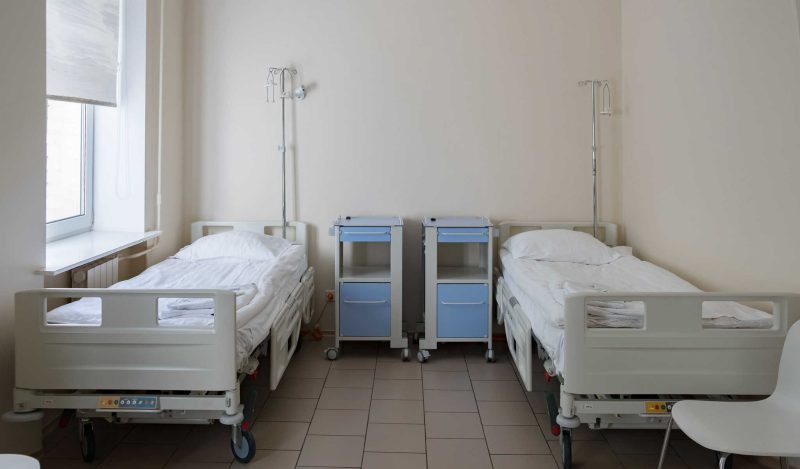Is this the smoking gun that proves hospital neglect and malfeasance, in the midst of a drummed up crisis environment, killed covid patients?
Daniel Horowitz recently interviewed Scott Schara, whose 19-year-old Down syndrome daughter Grace died of “covid” in Ascension’s St. Elizabeth’s Hospital.
In this stunning interview, Scott laid out the real-life horror movie of Grace’s experience in the hospital as a mentally disabled individual, culminating in her being sedated to death by hospital staff. According to him, the cruel indifference of the hospital was at least in part because Grace had Down Syndrome. (Scott created a website that contains all of his meticulously documented evidence and research where you can get all the sordid details for yourself.)
This “anecdote” aligns with the numerous and widely reported instances of the shocking descent of some hospital administrators and healthcare staff into depravity reminiscent of medical war crimes, one of the defining atrocities of the pandemic.
To give one quick example, Nicole Sirotek, founder of America’s Frontline Nurses, has been involved in “jailbreaking” a number of patients from hospitals where they were being abused and/or held against their will. She gave riveting testimony at Senator Ron Johnson’s Senate roundtable event “Covid 19: A Second Opinion.”
However, while vignettes of individual cases abound, there had not yet been any published data suggesting a direct link from hospital neglect to covid outcomes that would effectively be a smoking gun that hospital malfeasance was and is systematically killing patients.
Shedding light on this situation is a study published in Nature entitled “Trends and associated factors for Covid-19 hospitalisation and fatality risk in 2.3 million adults in England.” The goal of the study was to see if they could distill from the vast reams of UK hospital data throughout the pandemic what factors were most strongly associated with covid hospitalization and death. Here is what they found:
“Of 2,311,282 people included in the study, 164,046 (7.1%) were admitted and 53,156 (2.3%) died within 28 days of a positive Covid-19 test. We found significant variation in the case hospitalisation and mortality risk over time, which remained after accounting for the underlying risk of those infected. Older age groups, males, those resident in areas of greater socioeconomic deprivation, and those with obesity had higher odds of admission and death. People with severe mental illness and learning disability had the highest odds of admission and death.”
In plain English, they discovered that having a “severe mental illness or learning disability” was a stronger predictor than age and obesity of becoming hospitalized and dying from covid.
It is less clear why there should be higher rates of hospital admission for mentally incapacitated individuals. Regardless, even if there is a completely separate reason for higher hospitalization rates for mentally disabled people, the most plausible explanation why having a learning disability is a greater “comorbidity” than age or obesity is that hospitals/LTC’s are ‘treating them to death’ whether by oversedation or using other inappropriate medical interventions; or utter neglect.
To be fair, the authors noted that obesity “had higher risk of admission than those of a healthy weight, but mortality risk was lower in those overweight, which may indicate higher perceived risk amongst clinicians and a lower threshold for admission.”)
Anyone reading this is undoubtedly well aware that age and obesity have consistently been the two most lethal comorbid factors for covid outcomes. So how can having a severe mental illness or *learning disability* be more lethal than being 258 lbs or 87 years of age?
Now, it is theoretically possible that ‘severe mental illness’ is in reality catching underlying conditions that are the real culprit of the increased hospital admissions and deaths and not the mental illness itself, as people with severe mental illness often are also suffering from severe physiological problems (which are also sometimes contributing to their psychological impairments).
It is not remotely plausible that “learning disabilities” have a physiological connection or influence on the pathological course of covid infection or disease, certainly not en masse that would show up as a stronger safety signal than both age and obesity. The proposition that an otherwise perfectly healthy individual with a learning disability is at a higher risk from covid than your 83-year-old grandma is so absurd that it should call the entire study into doubt.
It is plausible though that hospitals were systematically taking advantage of patients who were mentally incapacitated and therefore especially susceptible to utter neglect, and/or unable to resist adverse “treatment” by medical providers.
The implications of this finding are significant. Although this particular study is analyzing UK data, considering what we know about the general scene in US hospitals, it is overwhelmingly likely that this finding would be replicable using US data (by honest researchers). Consider that it was widely reported by the mainstream media that there were already plans made to triage care away from disabled patients and not just the elderly, e.g. this NBC report.
More importantly, this is another datapoint in the broad mosaic of evidence pointing to the complicity of hospitals and other healthcare provider institutions in the deaths of perhaps hundreds of thousands of covid patients.
In a truly ironic twist, the study authors unwittingly captured the root issue quite accurately, concluding that “People with severe mental illness and learning disability were amongst those with the highest odds of both admission and mortality, indicating the need for proactive care in these groups.”
Is there evidence of similar behavior in the UK?
This is relevant insofar as showing that the mindset, willingness and the means to essentially euthanize patients exists independently of the allegations regarding mentally incapacitated patients in the UK, which would be powerful evidence affirming that the reason that mental disabilities are the most lethal ‘comorbidity’ is that they were selectively discriminated against on an institutional level to receive potentially lethal medical interventions.
CARE homes have been accused of using powerful sedatives to make coronavirus victims die more quickly. Prescriptions for the drug midazolam rocketed during the height of the pandemic, with some claiming it has “turned end-of-life care into euthanasia.”
UK: ‘You stayed at home, to protect the NHS, but they gave Midazolam to the Elderly and told you they were Covid Deaths.’ This is a brilliant and extremely thorough (and long) investigatory piece of the Midazolam scandal in the UK.
As Canada is very much culturally intertwined with the UK, it is noteworthy that the same phenomena are present in Canada as well:
Canada: Who Killed Granny? Pandemic Death Protocols in Canada’s Long-term Care Facilities.
That elderly nursing home residents represent a large proportion of Covid-19 fatalities is a familiar if sad fact to most Canadians. Even sadder and more disturbing would be if many of those deaths were avoidable. And if some were deliberate, it would be shocking and outrageous. In this investigative piece, Anna Farrow explores the widespread use of “population triage” in several jurisdictions during the pandemic’s early months. While healthcare establishments seemed woefully unprepared in nearly all respects, Farrow found they were lightning-quick to adopt what amounted to killer protocols on thousands of elderly and vulnerable citizens. This included not merely the withholding of advanced care but end-of-life measures using fatal drug cocktails.
Canada: Palliative care doctors worried about ‘potentially excessive’ dosages:
Several establishments in Quebec have already suspended the application of protocols, developed at the start of the COVID-19 pandemic, which aimed to relieve patients suffering from respiratory distress.
Starved and dehydrated
Canadians heard about it when the military were sent into elderly care homes in late April 2020. “To read Brigadier General C.J.J. Mialkowski’s report about the Ontario homes is to read a document that conveys in the precise, meticulous language of a soldier the horror the military personnel felt. It reads as dispatches from a new kind of battlefield,” Farrow states.
“There were common themes across the five facilities: lack of permanent, trained, and coordinated staff; misuse of narcotics; shortage of supplies; inadequate nutrition and hydration of residents.”
At risk of rehashing what I stated above, these scandals are a solid indication of the following:
- The medical profession is capable of sedating or otherwise ‘treating’ patients to death, both morally and practically.
- Medical institutions had developed protocols to systematically implement treatment regiments that result in the deaths of patients.
- Medical practitioner and healthcare worker whistleblowers claiming that hospitals and nursing homes were committing negligence or outright causing patient deaths are credible as a general matter.
This neatly fits in with the hypothesis that hospitals were systematically taking advantage of mentally disabled patients to withhold treatment, or worse, recklessly administer sedatives and ventilate them.
Join the conversation:


Published under a Creative Commons Attribution 4.0 International License
For reprints, please set the canonical link back to the original Brownstone Institute Article and Author.









